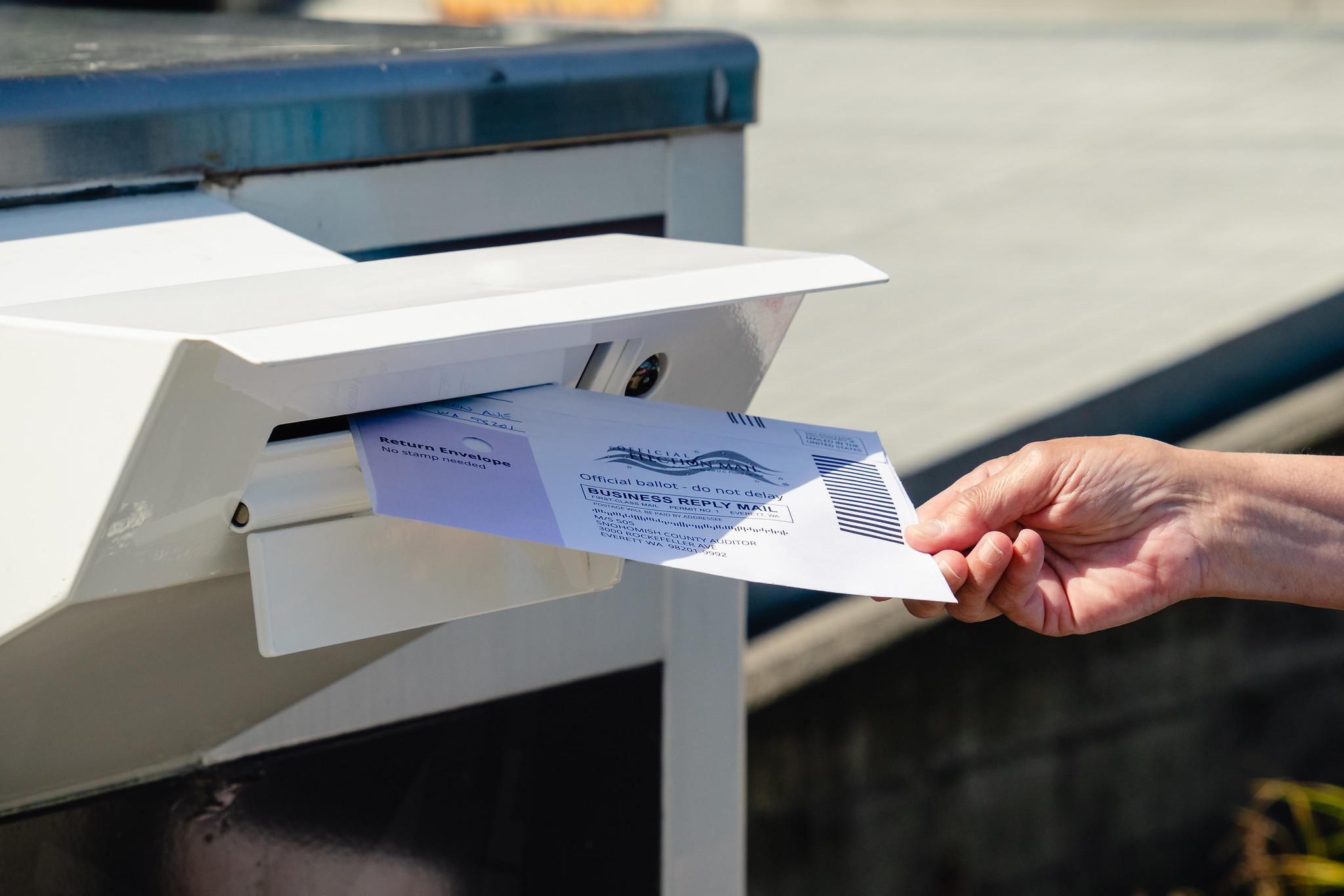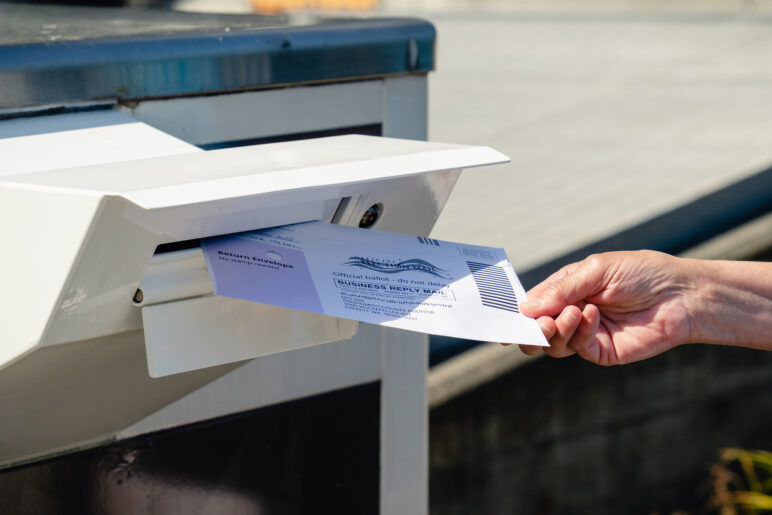Editor’s note: HB 1932 did not pass out of the Senate Ways & Means Committee by the February 26 deadline and will not advance.
For supporters of democracy, the equation should be simple. Higher turnout = better representation.
Research bears this out. Aligning local elections with higher-profile state and national races—in even-numbered years—boosts voter turnout more than any other change that election scholars have studied. Sightline’s recent analysis comparing 2021 and 2022 turnout in Washington showed that fully 62 percent more people—1.2 million Washingtonians—voted in the even-year election over the odd.
The sheer numbers speak for themselves; a democracy serves communities when more voters participate.
And digging into the academic studies regarding how voters understand and communicate their preferences confirms this conclusion, despite fears from critics. When more people vote, more people vote on local issues, and their ballots largely reflect their values and ideas—leading to better representation and a more responsive democracy.
To build a more representative democracy, then, we should do everything we can to increase voter participation when we have a choice.
What Washington voters and leaders need to know about even-year elections
1. Washington state could see far higher turnout for local offices—contrary to the naysayers
With House Bill 1932 in the 2024 legislative session, Washington state legislators have an opportunity to significantly increase participation in local elections across the state. HB 1932 would allow (but not require) cities and towns to move their elections to even-numbered years if they wish to do so. For jurisdictions that make the switch, turnout for mayor, city council, and other city offices would likely double, or more. Local government leaders could take advantage of the much greater turnout and govern with a clearer mandate from their constituents.
Opponents of this legislation are raising concerns that moving local elections to even-numbered years will result in voters who are uninformed about local issues or who will stop filling out a long ballot. KUOW reported in December that Washington Secretary of State Steve Hobbs “opposes the move to even-year elections. He argues that voters won’t have time to learn about local races, and there will be a lot of undervotes. He also thinks candidates for smaller races won’t be able to break through in grabbing voter attention.” These comments were echoed in public testimony last month from Secretary Hobbs’ office opposing HB 1932. Sec. Hobbs is not the only one—Seattle City Council president Sara Nelson, for example, has espoused similar views, as has the Seattle Times editorial board.
Concerns about undervotes and about voter attention and information are unwarranted. Evidence reveals that the increase in voter turnout in even years completely swamps any undervotes. And when people turn in a ballot, they are able to effectively communicate their interests—including on local issues, when the ballot is long, and with scant available information.
2. More voters means more votes for local offices—far more votes, not undervotes
The data show that undervotes are not a reasonable concern. More people vote for local offices during even years, not only on high-profile positions like US President or Senator.
Sightline has previously explored the issue of “undervoting,” also known as down-ballot drop-off—when voters stop voting for the races farther down the ballot, which tend to be local offices. We found that while drop-off occurs in almost all elections, the switch to even-year elections results in an increase in the total number of votes cast in local races: greater overall participation vastly outweighs the small amount of individual ballot drop-off. Oregon’s turnout for local elections is double that of Washington’s, after taking ballot drop-off into account.
If cities in Washington switched their elections to even years, local races, at the end of a ballot, would receive far greater voter participation than they do in the current odd-year elections. In other words, the total votes cast for local elections would be far higher in a switch to even years than the status quo.
3. Outcomes for voters demonstrate that they know—and vote—their own hearts and minds
Data on how voters understand and communicate their preferences are more complex. Scholarly research finds that 1) we do not definitively know how more bubbles on a ballot changes available information and voter decision-making and 2) we definitively do know that people voting in even-numbered years do a better job representing the interests of their community than voters in odd-numbered years—even if they may face longer ballots or might not remember as much about lower-profile races (more on this below). That’s because voters in even-numbered years tend to be a larger and more representative group of people.
A deeper dive into what research says about how voters engage in elections
Inconclusive: Voter behavior with long ballots
We don’t definitively know how more bubbles on a ballot changes voter decision-making: academic conclusions are mixed regarding how voters seek out and process the information needed to fill out their ballot. Some studies indicate that voters have less knowledge about lower-profile offices or issues when ballots are long. Others contradict this, finding evidence that that voters learn more about all offices when high-profile positions are on the same ballot, as they would be if local elections were held at the same time as state and federal offices in even-year elections.
Most of the scholarly research related to voter information and ballot length in general focuses on direct democracy—that is, when people vote directly on a specific policy issue via a ballot measure (e.g., Nicholson in his 2003 article on ballot proposition awareness). While a full discussion of that literature is beyond the scope of this article, most studies indicate that voters can get overwhelmed by too many ballot measures.1 And there are sometimes quite a few: Texas, for example, had 14 detailed ballot measures on its 2023 ballot.
The conclusions are less clear when it comes to electing representatives to public office. Ned Augenblick and Scott Nicholson of Stanford examined different ballot positions of the same proposition in California in their 2015 paper, and observe that longer ballots can increase the amount that voters use heuristics (mental shortcuts, like voting according to candidates’ party, class, endorsements, gender, and race), abstain from voting, or simply pick the first option on the ballot. Use of heuristics has benefits and drawbacks, as noted by Steenbergen and Colombo’s chapter on the subject in 2018: research suggests that all voters, in all elections, somewhat rely on these mental shortcuts, with some variations based on a voter’s level of education and overall political knowledge. Heuristics may introduce bias but also help voters make effective decisions when dealing with lots of information.
While Augenblick and Nicholson’s conclusions provide some evidence to be wary of long ballots, their data do not capture variations over time, changes in the composition of the electorate, or how voters behave differently in vote-by-mail settings or with comprehensive voter guides, all of which are essential to extrapolating their conclusions to changes in election timing in Washington state. Notably for all vote-by-mail states like Washington, they note that one might predict a smaller or negligible “choice fatigue” effect for absentee voters.
Inconclusive: Awareness of lower-profile and local offices with consolidated elections
When taking election timing into account, research on voter information and awareness is ambiguous. Comparing various aspects of US federal House elections in her 2009 article, researcher Jennifer Wolak finds that recognition and knowledge of House candidates is slightly higher when Senate races are more intense (as measured by spending), although she sees little effect from presidential elections. In other words, she found that voters are more likely to learn more about lower-profile races when they are paying attention to a high-profile race on the same ballot.
Looking at the same data pool, however, David Andersen shows in his 2023 research that name recall of lower-profile House candidates decreases as other offices are added to a ballot, which suggests that awareness of lower-profile offices diminishes as ballots get longer. Exploring other facets of the data, he sees no significant changes to political engagement beyond voting, such as participation in campaign activities, when additional higher-salience elections are on a ballot. But he confirms that engagement as measured by voter turnout is much higher.
Based on the findings from his research, Andersen suggests that “engagement is not very deep” (16) and echoes concerns that voters are not well-equipped to vote on lower-level offices. Yet these studies do not explore what level of engagement is sufficient for voters to represent their interests, nor do they account for differences in composition of the electorate or for the different information environments achieved by vote-by-mail and voter guides. In addition, both Wolak and Andersen explore how federal House races might be affected by higher-profile US Presidential or Senate races (all of which are in even-numbered years), which may or may not be applicable to the question of how much attention local offices receive when paired with national elections.
In one of the few studies that does explore voter information in local elections, University of Chicago and Public Policy Institute scholars J. Eric Oliver and Shang E. Ha show that voters in off-cycle elections are more likely to have their vote choice influenced by local issues (which makes sense, as local offices comprise a larger proportion of the ballot). They also find that there is no statistically significant difference in interest in local campaigns and knowledge of city council candidates in off-cycle years compared to on-cycle, even years—so voters do seem to still pay attention to local issues in even-numbered years.
In another study, this time of school district elections, Julia Payson (2017) observes that local news sources are just as likely to report on student achievement in even-numbered, on-cycle and odd-numbered, off-cycle years, combatting the idea that local issues will not receive any media attention when there are national elections at play.
Reviewed together, the available research does not come to conclusive answers regarding whether voters gain more or less information about local offices when other higher-profile positions are on the same ballot. Unlike what opponents of election consolidation suggest, moving local elections to even years would have an unknown or likely negligible effect on voter information and attention. And the omissions in the relevant studies and gaps in the research on voter information are essential to understanding how election consolidation could improve democratic representation, particularly for local offices in Washington state.
Conclusive: Winners of even-year elections better match “we the people”
Presumably, having well-informed voters is important so that they can effectively translate their interests onto the ballot and thereby into government policies and processes. With that objective in mind, scholarly research is conclusive: people voting in even-numbered years do a better job representing the interests of their community than voters in odd-numbered years. That’s because of the additional participation; voters in even-numbered years comprise a larger and more representative electorate.
Voter turnout is much lower in odd-numbered years than even-numbered years, and, as oft-cited political scholar Arend Lijphart noted in 1996, unequal participation spells unequal influence.2 Who votes determines what is heard in government.
A broad swath of studies has found that when turnout is low, the composition of the electorate changes. From Lijphart’s (1997) vast compilation of international studies to Oliver and Ha (2007)’s conclusions related to local suburban elections, academic research reveals that low-turnout elections tend to overrepresent people who are more educated, higher-income, older, or more likely to own homes.3 People who are more informed about local issues are typically of a certain demographic and tend to prioritize their own interests when voting.
Studies that specifically explore election timing point to similar trends about voter demographics, including recent Sightline research. They also show better alignment of political preferences during even-numbered (“on-cycle”) years. Scholars Hajnal, Kogan, and Markarian (2021) find that a shift to on-cycle elections in California led to a strikingly more representative electorate in terms of race, age, and partisanship. And researchers Hartney and Hayes (2021) conclude that on-cycle (even-year) elections are more aligned with the political preferences of the people they represent than those chosen in off-cycle (odd-year) elections; also, when state governments mandate off-cycle elections, school board decisions are more likely to differ from preferences of average voters. Regarding how elected representatives are answerable to voters, Payson (2017) surmises that school board incumbents are more likely to be held accountable to school district performance in even-numbered election years than in odd.
Most of these studies move past analysis of the information voters have, which is difficult to measure precisely, in favor of examining election outcomes. The real-world results indicate that even if the larger group of voters in an on-cycle election relies more on heuristics with a longer ballot, they still do a better job representing the interests of the community as a whole than does the small electorate voting in off-cycle elections.
If local government leaders are more representative of their communities, more aligned with the preferences of their constituents, and more accountable when their elections are held at the same time as other offices, it’s clear that voters are sufficiently informed and aware to make the choices right for them.
The worrying implications of emphasizing voter information at the cost of participation
An overemphasis on the need for voters to be “well-informed” as a prerequisite for participation (or for policies that encourage broader participation among more voters) leads down a dangerous path, and not simply because it’s impossible to determine what amounts to adequate information.
A functioning democracy relies on voter participation, first and foremost. When concern for an informed electorate is used as an argument in favor of low-turnout elections, it has the whiff of poll taxes, literacy tests, and the like—and we know that what was behind those ideas was not genuine concern for effective democracy.
In the conclusion to his 2023 paper, Andersen explicitly asks, “Is it normatively better to have a wide canvass of uninformed voters, or a low-turnout but better-informed electorate?” While the question is rhetorical, it suggests that voters should possess a certain level of information to participate—an implication that runs counter to foundational American ideas about democracy and equality.
One might—and should—reasonably ask how to improve the information that potential voters receive and what can be done to facilitate citizen understanding of government, from boosting K-12 civics education to plain-language voter pamphlets, from participatory budgeting to any number of other means to engage the public on an ongoing basis. But none of this need come at the cost of limiting voter access. Indeed, referring to fears about voter information in their 2003 paper on election timing, scholars Zoltan Hajnal and Paul Lewis write,
These concerns are solid arguments for civic education, voter outreach campaigns, higher quality media coverage of local races, and intensive campaigning by candidates for mayor and council. They are, in our view, not good arguments for scheduling local elections so as to knowingly reduce public participation. (662)
To have an effective democracy, we should question how best to hold our representatives accountable to the values and wishes of their constituents. Timing elections to encourage a large and representative electorate, through a shift to holding local elections in even-numbered years, helps move towards that aspiration. Raising spurious doubts about voter awareness does not.
Washington’s legislature can turbocharge voter participation
The reasons to allow jurisdictions in Washington to shift local elections to even years stack up overwhelmingly against the cautions piled on by the naysayers, and are backed up by research and evidence. State legislators have a chance to turbocharge voter participation in local races.
If local elections move to even-numbered years, Washingtonians might get lengthier ballots, and they’ll have to sort out their preferences and work through who is going to represent them best—just like they always do. Fortunately, living in a vote-by-mail state, they’ll have time to do that outside of a polling booth. And as studies have shown, once people get to voting, they do a pretty good job representing their interests.
Moving local races to higher-turnout even-numbered years is not the only tool we have to improve democracy, nor should it be. But we can start by showing that we value and trust voters by easing basic electoral participation and moving elections to the time that works best for them.
In Washington, state legislators have an opportunity to help build a democracy where more people elect the local leaders who attend to the issues that matter to their daily lives. House Bill 1932 would remove the mandate on odd-year elections, giving local governments the option to meet voters when they vote.










